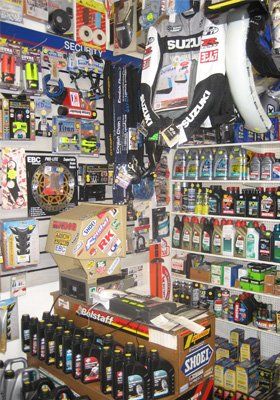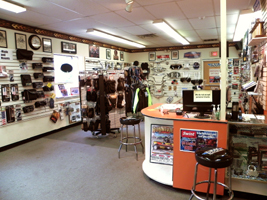Essential Motorcycle Parts NZ for Peak Performance and Security
Essential Motorcycle Parts NZ for Peak Performance and Security
Blog Article
Recognizing the Important Parts of a Motorcycle: A Comprehensive Overview for Enthusiasts
For bike lovers wanting to elevate their riding experience and guarantee their bikes run smoothly, comprehending the essential elements of a motorcycle is critical. Each element, from the engine's intricate functions to the crucial duty of the braking mechanisms, not only affects performance but also safety and security and comfort. This guide will certainly go through the fundamental components that every cyclist should know with, allowing notified choices in both upkeep and possible upgrades. As we begin this expedition, one must ask: just how does each element engage to develop the smooth ride every fanatic looks for?
Engine Parts

The camshaft plays an essential function in controlling the timing of the engine's shutoffs, making sure the accurate opening and closing necessary for effective gas and air intake, in addition to exhaust expulsion. This timing is essential to keeping optimal engine efficiency and effectiveness. Additionally, the carburetor or gas injection system, depending on the motorcycle version, is liable for blending air with gas in the appropriate proportion for combustion.
The air conditioning system, either air or liquid-based, works to keep the engine's temperature within functional limitations, stopping getting too hot and guaranteeing durability - mx gear nz. Each element, meticulously designed and integrated, contributes to the smooth procedure of the engine, specifying the bike's power outcome and total efficiency
Transmission System
Essential to the motorcycle's performance, the transmission system makes sure efficient power transfer from the engine to the wheels. This system makes up numerous important components, including the clutch, transmission, and last drive, each playing a crucial duty in translating the engine's power into activity. The clutch, usually operated by a hand lever, offers to involve and disengage the engine from the transmission, permitting for smooth equipment modifications and controlled acceleration.
The gearbox, often described as the transmission proper, contains a collection of equipments that bikers can by hand move through to adjust the bike's speed and torque result. These equipments are organized in a series that allows the motorcycle to speed up smoothly and preserve ideal engine efficiency throughout various speeds. A lot of motorbikes make use of a sequential transmission, needing the biker to change equipments in an established order.
Braking Devices
While recognizing the transmission system is crucial to utilizing a motorbike's power, similarly vital is the capacity to control and stop that power efficiently, which is where braking mechanisms enter into play. Brakes are vital for view safety and security and performance, supplying the cyclist with the required control to navigate various terrains and conditions. Normally, motorbikes feature 2 sorts of braking systems: disc brakes and drum brakes.
Disc brakes are a lot more common vegan motorcycle gear in contemporary motorbikes due to their remarkable efficiency. This system provides far better warmth dissipation, constant performance, and enhanced quiting power, especially in damp conditions.
Conversely, drum brakes, though less typical, are still located in some motorcycles. They work by pushing brake footwear versus the internal surface area of a drum affixed to the wheel. While generally much less reliable in warm dissipation and stopping power, drum brakes are easier and more cost-effective.
Recognizing these stopping systems' nuances allows riders to keep their motorbikes correctly and value the engineering that makes sure efficient and risk-free quiting.
Suspension and Steering
Suspension and steering systems are vital elements that substantially influence a bike's handling and trip convenience. The shock absorber, consisting of forks at the front and shock absorbers at the rear, takes in road irregularities, boosting stability and control. Front forks, inverted or typically telescopic, compress and rebound to mitigate effects, while back shock absorbers keep tire call with the road, critical for traction and safety.
Guiding, centered around the handlebars, connects the motorcyclist to the bike's directional control. The guiding head bearings guarantee smooth operation, enabling accurate ability to move. Correct placement and upkeep of these bearings are critical for foreseeable steering reaction and lowering cyclist fatigue.
The suspension's adjustability is another crucial element; preload, damping, and rebound setups enable customization to suit different riding styles and problems. This versatility is vital for maximizing efficiency, whether browsing metropolitan roads or tackling sturdy trails. Technologies like digital shock go to this site absorber supply real-time adjustments, enhancing trip quality throughout diverse terrains.

Electrical Solutions
After guaranteeing a regulated and smooth ride through efficient suspension and guiding systems, focus transforms to the electric systems, a pivotal facet of modern bikes. These systems play an essential duty not just in starting the engine yet additionally in powering various components that improve the functionality and security of the bike.
At the heart of a motorbike's electric system is the battery, which shops electric energy essential for beginning the engine and powering auxiliary systems - motorcycle shop. The generator or generator, coupled with the rectifier-regulator, makes sure the battery continues to be billed while the bike functions, converting mechanical power into electric power and preserving voltage levels
The ignition system, an additional vital element, is accountable for stiring up the air-fuel combination in the engine's cylinders. Modern motorcycles usually use a digital ignition system, offering greater performance and integrity compared to traditional systems.
Illumination systems, consisting of headlights, tail lights, and indications, are additionally important, guaranteeing exposure and safety and security for the motorcyclist. Extra electronic parts such as sensing units, control devices, and displays contribute to innovative features like fuel injection management, anti-lock braking systems (ABDOMINAL MUSCLE), and digital control panels, further boosting the riding experience.
Verdict
A comprehensive comprehension of a bike's necessary components, including the engine, transmission system, braking systems, suspension, steering, and electrical systems, is essential for lovers intending to enhance security, performance, and comfort. Mastery of these components permits informed decisions relating to maintenance and upgrades, inevitably enhancing the riding experience. By integrating this expertise, cyclists can guarantee their motorcycles run at peak effectiveness and reliability, consequently optimizing both pleasure and long life of their automobiles.
For bike fanatics looking to boost their riding experience and ensure their bikes run efficiently, understanding the essential parts of a bike is critical.Integral to the bike's functionality, the transmission system makes certain efficient power transfer from the engine to the wheels.While recognizing the transmission system is key to harnessing a bike's power, equally vital is the capacity to manage and quit that power successfully, which is where braking mechanisms come right into play. Generally, motorbikes include two types of braking systems: disc brakes and drum brakes.
A detailed comprehension of a bike's necessary parts, consisting of the engine, transmission system, braking devices, suspension, guiding, and electrical systems, is indispensable for fanatics intending to enhance convenience, performance, and safety.
Report this page